Optimized Design with Artificial Intelligence Quantum Dot White Mini LED Backlight Module Development
Abstract
:1. Introduction
2. Experiment and Algorithm Design
2.1. Mini-LED Module Design
2.2. Overall Design Workflow
2.3. Definitions of Action Functions, State Functions, and Reward Functions of DDQN Algorithm
- The online and target networks are initialized;
- At each time step, an action is selected from the online network based on the current state of the state space (St);
- The selected action is performed, the next state is observed, and the environmental feedback is rewarded.
- The next action from the target network is selected as an action space (at), and its Q-value is evaluated.
- The Q estimate for the online network is updated using the next state of the feedback and the reward function (rt);
- The target network is regularly updated by copying the parameters from the online network to the target network;
- Steps 2 through 6 are repeated until the desired stop condition is reached.
3. Result
3.1. Divergent Angle of Single Packaged Mini-LED
3.2. Experimental Result for DDQN
3.3. QD Color Conversion and Reliability Test of the Mini-LED Backlight Module
4. Conclusions
Author Contributions
Funding
Data Availability Statement
Acknowledgments
Conflicts of Interest
References
- Kizilyalli, I.C.; Edwards, A.P.; Nie, H.; Disney, D.; Bour, D. High Voltage Vertical GaN p-n Diodes with Avalanche Capability. IEEE Trans. Electron Devices 2013, 60, 3067–3070. [Google Scholar] [CrossRef]
- Pimputkar, S.; Speck, J.S.; DenBaars, S.P.; Nakamura, S. Prospects for LED lighting. Nat. Photonics 2009, 3, 180–182. [Google Scholar] [CrossRef]
- Huang, C.-H.; Chen, K.-J.; Tsai, M.-T.; Shih, M.-H.; Sun, C.-W.; Lee, W.-I.; Lin, C.-C.; Kuo, H.-C. High-efficiency and low assembly-dependent chip-scale package for white light-emitting diodes. J. Photonics Energy 2015, 5, 057606. [Google Scholar] [CrossRef]
- Wu, T.; Sher, C.-W.; Lin, Y.; Lee, C.-F.; Liang, S.; Lu, Y.; Huang Chen, S.-W.; Guo, W.; Kuo, H.-C.; Chen, Z. Mini-LED and micro-LED: Promising candidates for the next generation display technology. Appl. Sci. 2018, 8, 1557. [Google Scholar] [CrossRef]
- West, R.S.; Konijn, H.; Sillevis-Smitt, W.; Kuppens, S.; Pfeffer, N.; Martynov, Y.; Takaaki, Y.; Eberle, S.; Harbers, G.; Tan, T.W.; et al. 43.4: High Brightness Direct LED Backlight for LCD-TV. In SID Symposium Digest of Technical Papers; Blackwell Publishing Ltd.: Oxford, UK, 2003; Volume 34, pp. 1262–1265. [Google Scholar] [CrossRef]
- Hsiang, E.-L.; Yang, Z.; Yang, Q.; Lan, Y.-F.; Wu, S.-T. Prospects and challenges of mini-LED, OLED, and micro-LED displays. J. Soc. Inf. Disp. 2021, 29, 446–465. [Google Scholar] [CrossRef]
- Yang, Z.; Hsiang, E.-L.; Qian, Y.; Wu, S.-T. Performance Comparison between Mini-LED Backlit LCD and OLED Display for 15.6-Inch Notebook Computers. Appl. Sci. 2022, 12, 1239. [Google Scholar] [CrossRef]
- Gao, Z.; Ning, H.; Yao, R.; Xu, W.; Zou, W.; Guo, C.; Luo, D.; Xu, H.; Xiao, J. Mini-LED Backlight Technology Progress for Liquid Crystal Display. Crystals 2022, 12, 313. [Google Scholar] [CrossRef]
- Chen, E.; Guo, J.; Jiang, Z.; Shen, Q.; Ye, Y.; Xu, S.; Sun, J.; Yan, Q.; Guo, T. Edge/direct-lit hybrid mini-LED backlight with U-grooved light guiding plates for local dimming. Opt. Express 2021, 29, 12179–12194. [Google Scholar] [CrossRef]
- Gong, Z.; Jin, S.; Chen, Y.; McKendry, J.; Massoubre, D.; Watson, I.M.; Gu, E.; Dawson, M.D. Size-dependent light output, spectral shift, and self-heating of 400 nm InGaN light-emitting diodes. J. Appl. Phys. 2010, 107, 013103. [Google Scholar] [CrossRef]
- Huang, Y.; Hsiang, E.-L.; Deng, M.-Y.; Wu, S.-T. Mini-LED, Micro-LED and OLED displays: Present status and future perspectives. Light: Sci. Appl. 2020, 9, 105. [Google Scholar] [CrossRef]
- Chen, H.; Sung, J.; Ha, T.; Park, Y. Locally pixel-compensated backlight dimming on LED-backlit LCD TV. J. Soc. Inf. Disp. 2007, 15, 981–988. [Google Scholar] [CrossRef]
- Yin, Y.; Peng, W.; Geng, J.; Bai, X.; Duan, M.; Wu, Y.; Hou, J.; Li, D.; Hwang, J.; Zhang, X.; et al. 18.4: Full-Color Active-matrix Mini-LED Display based on Novel Color Conversion Technology. SID Symp. Dig. Tech. Pap. 2021, 52, 244–246. [Google Scholar] [CrossRef]
- Chen, C.-J.; Lien, J.-Y.; Chiang, R.-K. P-115: Patternable and Ultra-Thin Quantum Dot Color Conversion Layer for Mini-Sized White Light LED Backlight. In SID Symposium Digest of Technical Papers; Blackwell Publishing Ltd.: Oxford, UK, 2019; Volume 50, pp. 1681–1684. [Google Scholar] [CrossRef]
- Lee, T.-Y.; Miao, W.-C.; Hung, Y.-Y.; Bai, Y.-H.; Chen, P.-T.; Huang, W.-T.; Chen, K.-A.; Lin, C.-C.; Chen, F.-C.; Hong, Y.-H.; et al. Ameliorating Uniformity and Color Conversion Efficiency in Quantum Dot-Based Micro-LED Displays through Blue–UV Hybrid Structures. Nanomaterials 2023, 13, 2099. [Google Scholar] [PubMed]
- Lee, T.-Y.; Hsieh, T.-H.; Miao, W.-C.; James Singh, K.; Li, Y.; Tu, C.-C.; Chen, F.-C.; Lu, W.-C.; Kuo, H.-C. High-Reliability Perovskite Quantum Dots Using Atomic Layer Deposition Passivation for Novel Photonic Applications. Nanomaterials 2022, 12, 4140. [Google Scholar] [CrossRef] [PubMed]
- Huang, Y.M.; Ahmed, T.; Liu, A.C.; Chen, S.W.H.; Liang, K.L.; Liou, Y.H.; Ting, C.C.; Kuo, W.H.; Fang, Y.H.; Lin, C.C.; et al. High-Stability Quantum Dot-Converted 3-in-1 Full-Color Mini-Light-Emitting Diodes Passivated with Low-Temperature Atomic Layer Deposition. IEEE Trans. Electron Devices 2021, 68, 597–601. [Google Scholar] [CrossRef]
- Sven-Silvius, S.; Neubert, B.; Eichler, C.; Scherer, M.; Habel, F.; Seyboth, M.; Scholz, F.; Hofstetter, D.; Unger, P.; Schmid, W.; et al. Absorption and light scattering in InGaN-on-sapphire- and AlGaInP-based light-emitting diodes. J. Light. Technol. 2004, 22, 2323–2332. [Google Scholar] [CrossRef]
- Arulkumaran, K.; Deisenroth, M.P.; Brundage, M.; Bharath, A.A. Deep Reinforcement Learning: A Brief Survey. IEEE Signal Process. Mag. 2017, 34, 26–38. [Google Scholar] [CrossRef]
- Sutton, R.S.; Barto, A.G. Reinforcement Learning: An Introduction; MIT Press: Cambridge, MA, USA, 2018. [Google Scholar]
- Silver, D.; Huang, A.; Maddison, C.J.; Guez, A.; Sifre, L.; van den Driessche, G.; Schrittwieser, J.; Antonoglou, I.; Panneershelvam, V.; Lanctot, M.; et al. Mastering the game of Go with deep neural networks and tree search. Nature 2016, 529, 484–489. [Google Scholar] [CrossRef]
- Huang, C.-H.; Cheng, Y.-T.; Tsao, Y.-C.; Liu, X.; Kuo, H.-C. Micro-LED backlight module by deep reinforcement learning and micro-macro-hybrid environment control agent. Photon. Res. 2022, 10, 269–279. [Google Scholar] [CrossRef]
- Hasselt, H. Double Q-learning. In Advances in Neural Information Processing Systems, Proceedings of the NIPS 2010, Vancouver, BC, Canada, 6–9 December 2010; Curran Associates, Inc.: Red Hook, NY, USA, 2010; Volume 23, p. 23. [Google Scholar]
- Hessel, M.; Modayil, J.; Van Hasselt, H.; Schaul, T.; Ostrovski, G.; Dabney, W.; Horgan, D.; Piot, B.; Azar, M.; Silver, D. Rainbow: Combining improvements in deep reinforcement learning. In Proceedings of the Thirty-Second AAAI Conference on Artificial Intelligence, New Orleans, LA, USA, 2–7 February 2018. [Google Scholar]
- Lillicrap, T.P.; Hunt, J.J.; Pritzel, A.; Heess, N.; Erez, T.; Tassa, Y.; Silver, D.; Wierstra, D. Continuous control with deep reinforcement learning. arXiv 2015, arXiv:1509.02971. [Google Scholar]
- Sewak, M. Deep Q Network (DQN), Double DQN, and Dueling DQN. In Deep Reinforcement Learning: Frontiers of Artificial Intelligence; Sewak, M., Ed.; Springer: Singapore, 2019; pp. 95–108. [Google Scholar] [CrossRef]
- Brim, A. Deep Reinforcement Learning Pairs Trading with a Double Deep Q-Network. In Proceedings of the 2020 10th Annual Computing and Communication Workshop and Conference (CCWC), Las Vegas, NV, USA, 6–8 January 2020; pp. 0222–0227. [Google Scholar]
- Han, B.A.; Yang, J.J. Research on Adaptive Job Shop Scheduling Problems Based on Dueling Double DQN. IEEE Access 2020, 8, 186474–186495. [Google Scholar] [CrossRef]
- Salh, A.; Audah, L.; Alhartomi, M.A.; Kim, K.S.; Alsamhi, S.H.; Almalki, F.A.; Abdullah, Q.; Saif, A.; Algethami, H. Smart Packet Transmission Scheduling in Cognitive IoT Systems: DDQN Based Approach. IEEE Access 2022, 10, 50023–50036. [Google Scholar] [CrossRef]
- Salh, A.; Audah, L.; Kim, K.S.; Alsamhi, S.H.; Alhartomi, M.A.; Abdullah, Q.; Almalki, F.A.; Algethami, H. Refiner GAN Algorithmically Enabled Deep-RL for Guaranteed Traffic Packets in Real-Time URLLC B5G Communication Systems. IEEE Access 2022, 10, 50662–50676. [Google Scholar] [CrossRef]
- Asmail, C. Bidirectional Scattering Distribution Function (BSDF): A Systematized Bibliography. J. Res. Natl. Inst. Stand. Technol. 1991, 96, 215–223. [Google Scholar] [CrossRef] [PubMed]
- Leloup, F.B.; Forment, S.; Dutré, P.; Pointer, M.R.; Hanselaer, P. Design of an instrument for measuring the spectral bidirectional scatter distribution function. Appl. Opt. 2008, 47, 5454–5467. [Google Scholar] [CrossRef]
- Ward, G.; Mistrick, R.; Lee, E.S.; McNeil, A.; Jonsson, J. Simulating the Daylight Performance of Complex Fenestration Systems Using Bidirectional Scattering Distribution Functions within Radiance. LEUKOS 2011, 7, 241–261. [Google Scholar] [CrossRef]

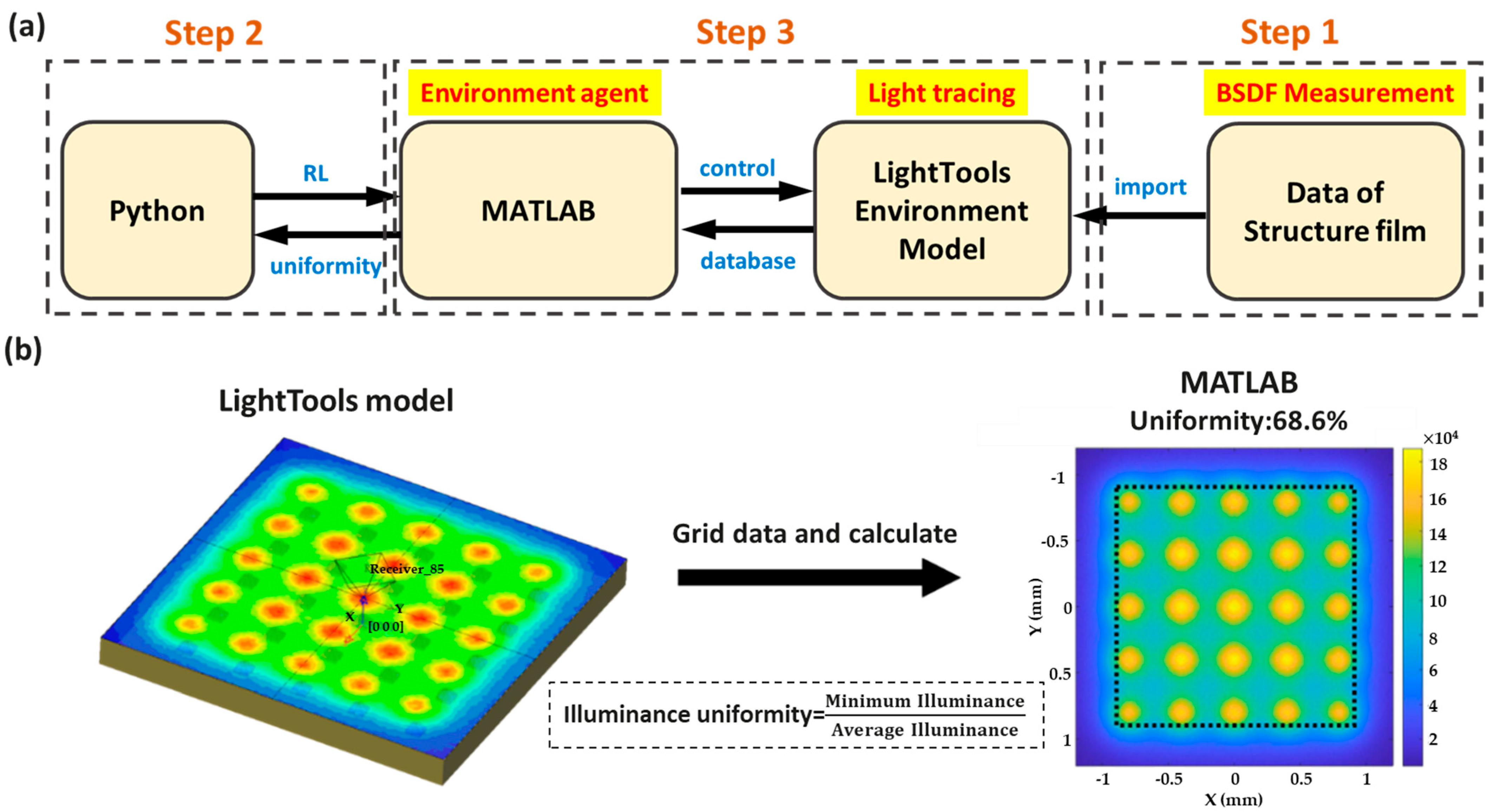
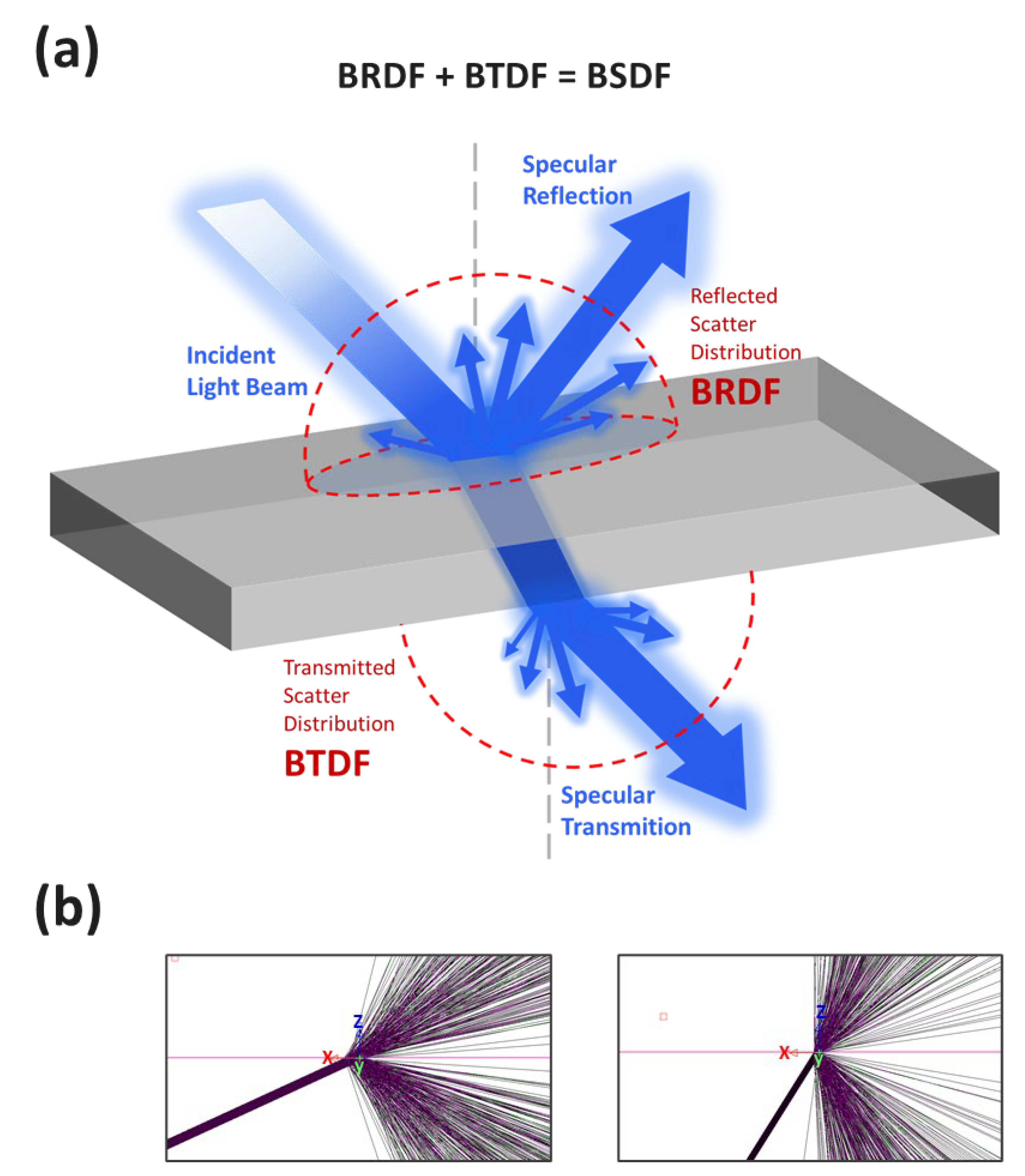
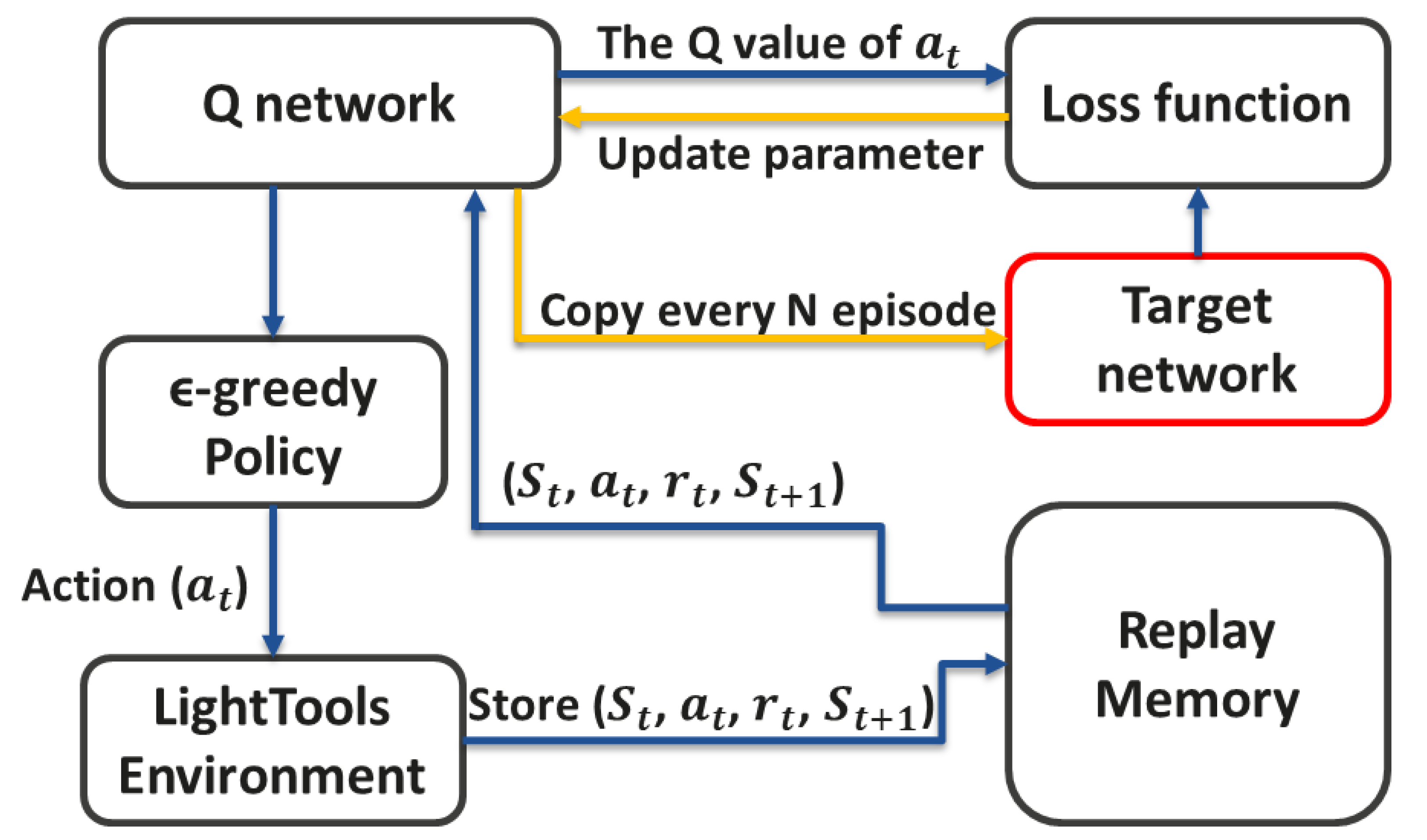
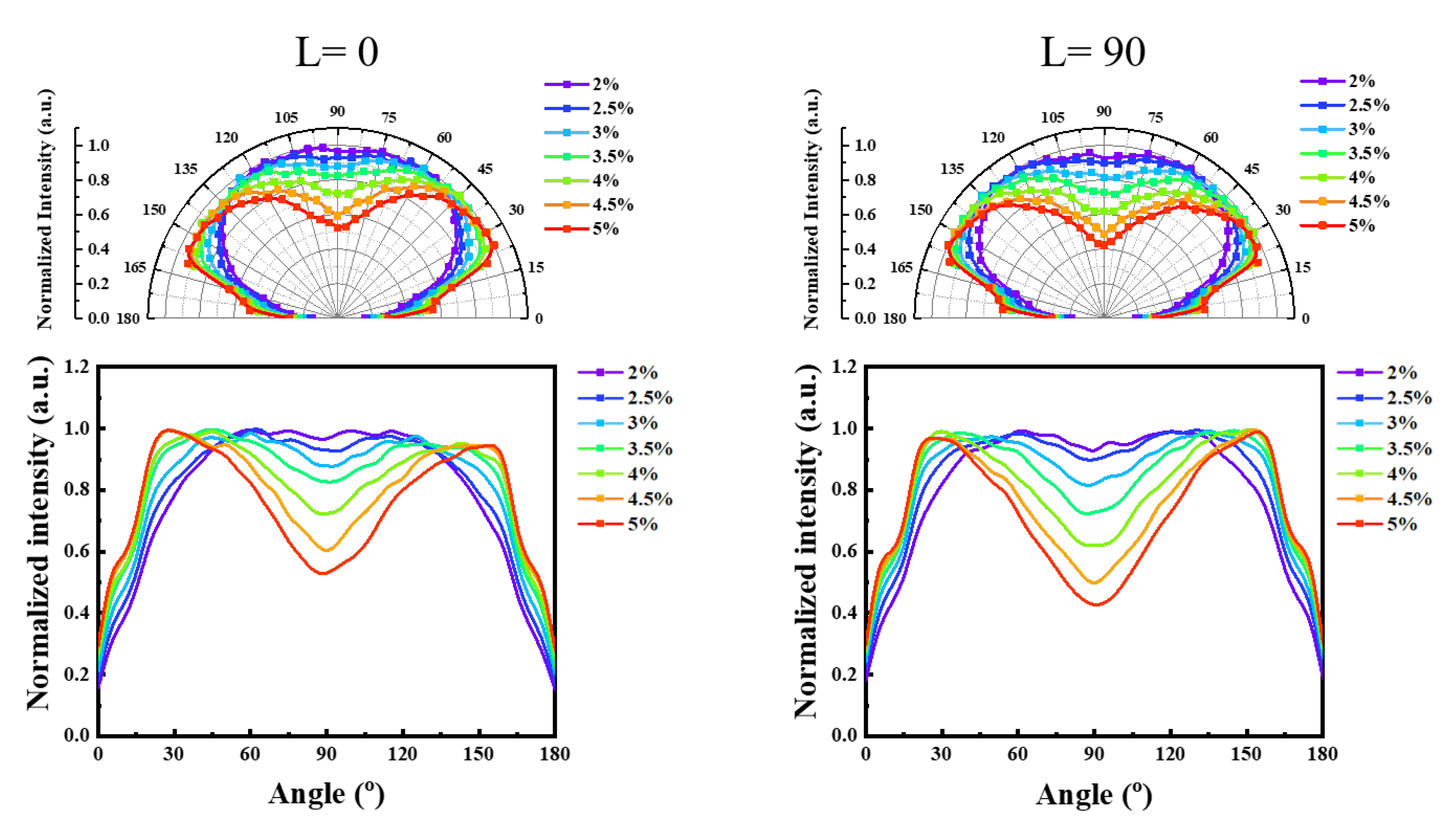


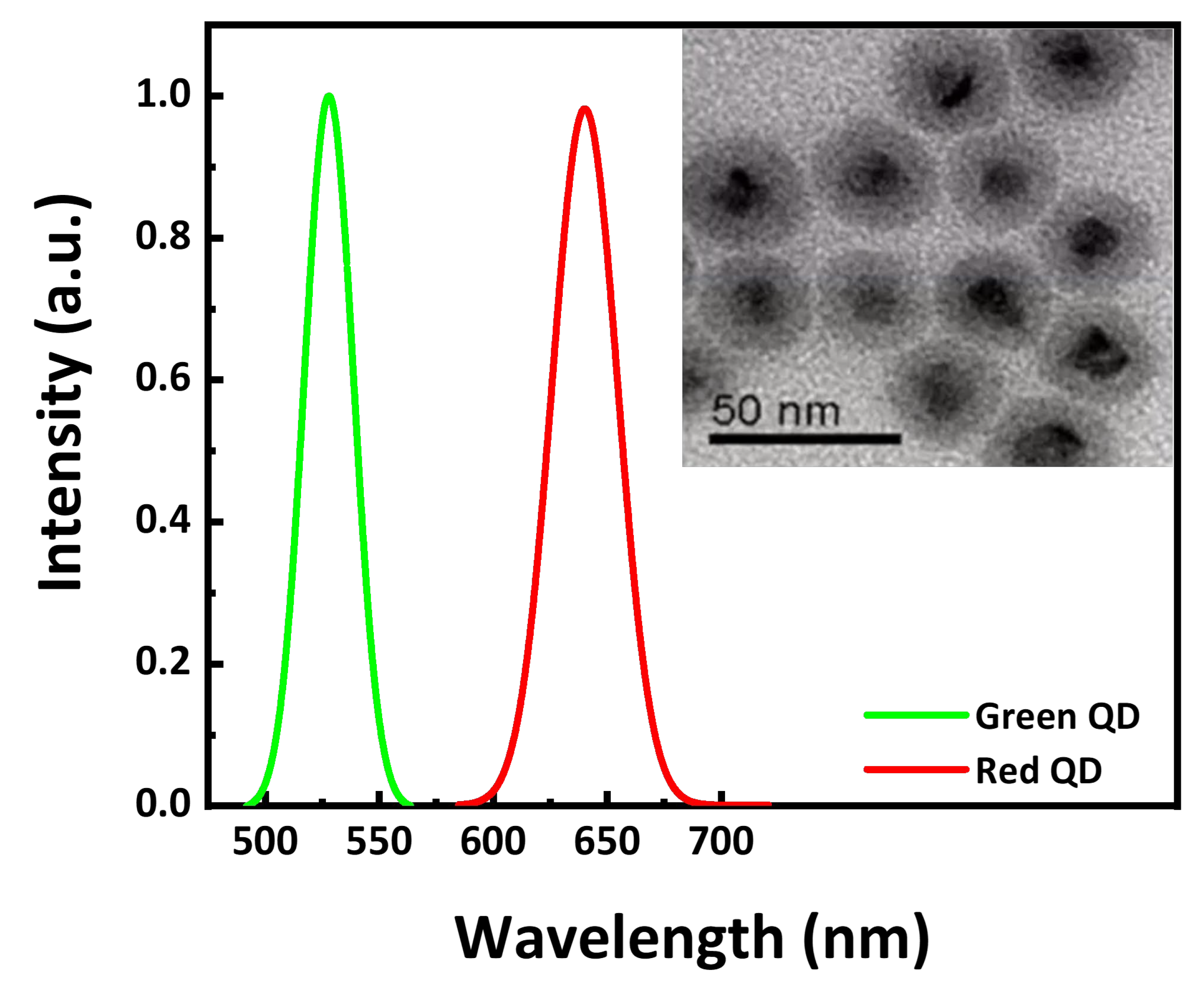
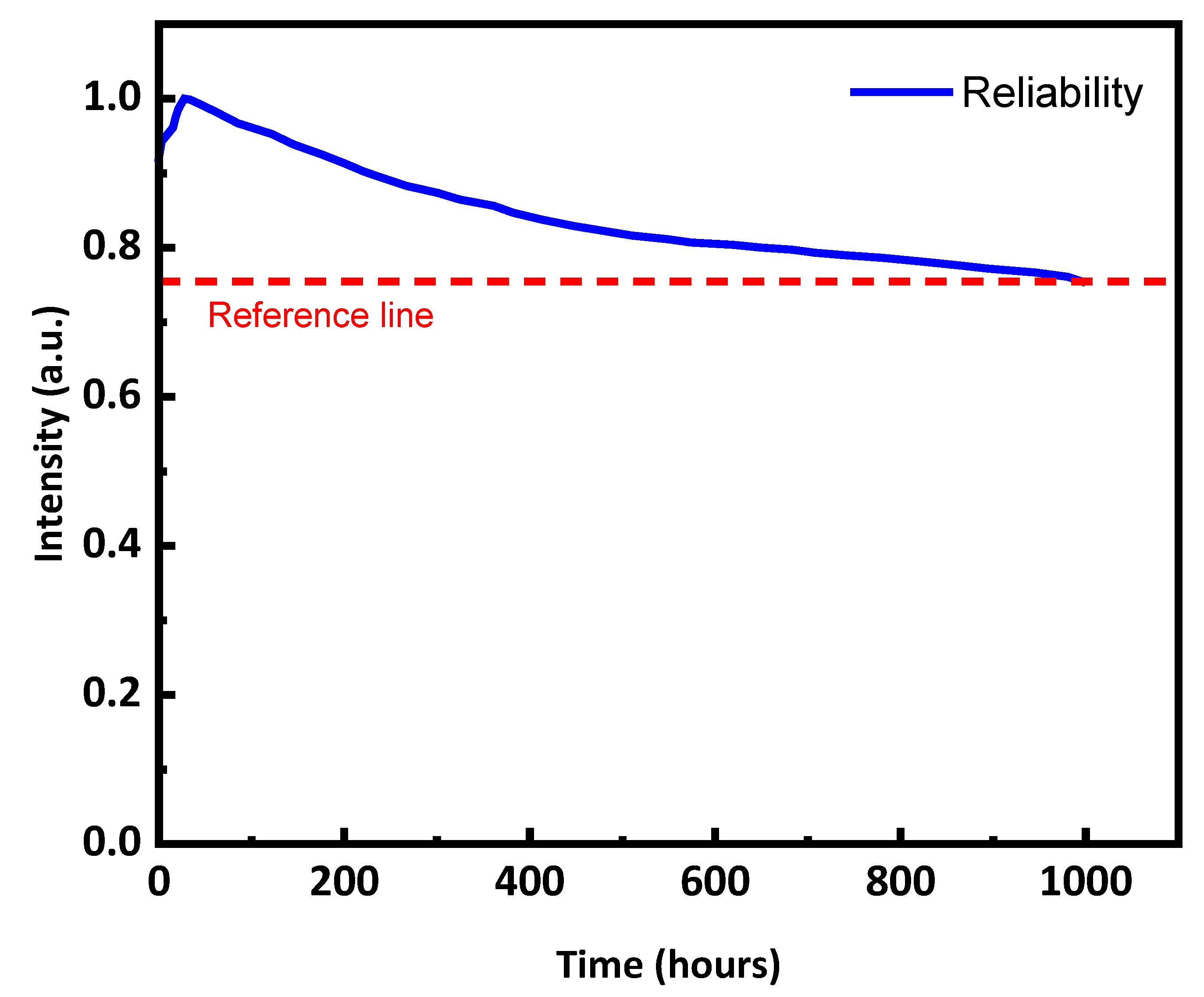
| Parameters | Symbol | Range |
|---|---|---|
| Width of transparent layer | a | 30 μm to 200 μm, step: 10 μm |
| Thickness of transparent layer | b | 30 μm to 140 μm, step: 10 μm |
| Thickness of diffusor layer | c | 30 μm to 140 μm, step: 10 μm |
| Weight concentration of TiO2 | d | 0.1% to 30%, step: 0.1% |
| State Space (St) | Action Space (at) | Reward Function (rt) | |||
|---|---|---|---|---|---|
| State No. | State Definition | Action No. | Action Definition | Reward No. | Reward Definition |
| S1 | The value of a | a1, a2 | increase a, decrease a | u | Illuminance uniformity = Minimum Illuminance/Average Illuminance |
| S2 | The value of b | a3, a4 | increase b, decrease b | r | r1 = (Uniformitynew − 73)3/1000 r2 = (unew − uold)/100 R (out of range) = −10 |
| S3 | The value of c | a5, a6 | increase c, decrease c | ||
| S4 | The value of d | a7, a8 | increase d, decrease d | ||
| Weight Concentration | 2 | 2.5 | 3 | 3.5 | 4 | 4.5 | 5 | |
|---|---|---|---|---|---|---|---|---|
| Divergence Angle | ||||||||
| L = 0 | 141 | 146 | 152 | 156 | 165 | 166 | 167 | |
| L = 90 | 147 | 152 | 161 | 170 | 171 | 168 | 167 | |
Disclaimer/Publisher’s Note: The statements, opinions and data contained in all publications are solely those of the individual author(s) and contributor(s) and not of MDPI and/or the editor(s). MDPI and/or the editor(s) disclaim responsibility for any injury to people or property resulting from any ideas, methods, instructions or products referred to in the content. |
© 2023 by the authors. Licensee MDPI, Basel, Switzerland. This article is an open access article distributed under the terms and conditions of the Creative Commons Attribution (CC BY) license (https://creativecommons.org/licenses/by/4.0/).
Share and Cite
Lee, T.-Y.; Huang, W.-T.; Chen, J.-H.; Liu, W.-B.; Chang, S.-W.; Chen, F.-C.; Kuo, H.-C. Optimized Design with Artificial Intelligence Quantum Dot White Mini LED Backlight Module Development. Crystals 2023, 13, 1411. https://doi.org/10.3390/cryst13101411
Lee T-Y, Huang W-T, Chen J-H, Liu W-B, Chang S-W, Chen F-C, Kuo H-C. Optimized Design with Artificial Intelligence Quantum Dot White Mini LED Backlight Module Development. Crystals. 2023; 13(10):1411. https://doi.org/10.3390/cryst13101411
Chicago/Turabian StyleLee, Tzu-Yi, Wei-Ta Huang, Jo-Hsiang Chen, Wei-Bo Liu, Shu-Wei Chang, Fang-Chung Chen, and Hao-Chung Kuo. 2023. "Optimized Design with Artificial Intelligence Quantum Dot White Mini LED Backlight Module Development" Crystals 13, no. 10: 1411. https://doi.org/10.3390/cryst13101411
APA StyleLee, T.-Y., Huang, W.-T., Chen, J.-H., Liu, W.-B., Chang, S.-W., Chen, F.-C., & Kuo, H.-C. (2023). Optimized Design with Artificial Intelligence Quantum Dot White Mini LED Backlight Module Development. Crystals, 13(10), 1411. https://doi.org/10.3390/cryst13101411








